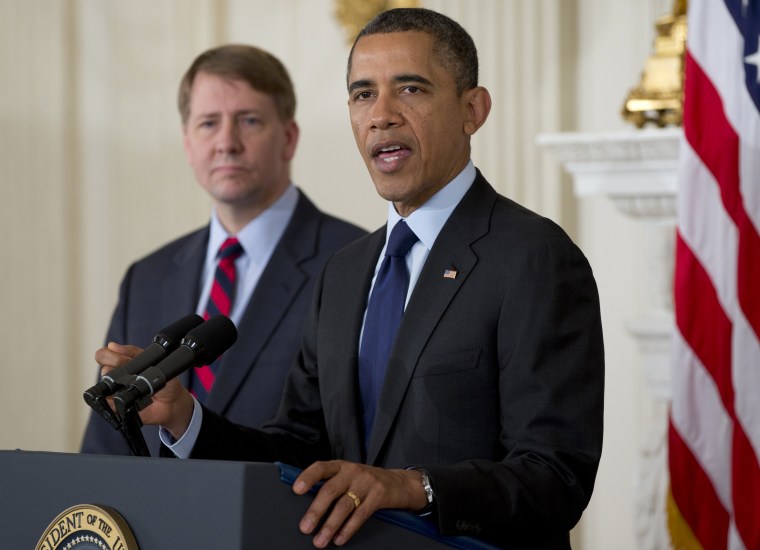Updated June 24, 9:55 a.m. - The Supreme Court agreed to take the case, which will decide when a president can use the recess appointment to fill government vacancies.
A major constitutional showdown is on track to reach the Supreme Court this fall. It could change the balance of power in Washington, making it easier for the Senate to block the president from filling important government jobs.
And in a flashback to Bill Clinton’s most infamous moment, the case comes down to this: what does the word “the” mean? That’s a fight only a lawyer could love. But the ramifications are sweeping.
The Obama administration last week asked the Supreme Court to hear the case, National Labor Relations Board v. Noel Canning. The court likely will do so. And if it rejects the administration’s position, a longstanding presidential power will be effectively dead.
The fight is over the president’s “recess appointment” power. The Constitution says the Senate must vote to confirm high-ranking government officers, such as Cabinet secretaries and federal judges. But it also gives the president a loophole: He has the “Power to fill up all Vacancies that may happen during the Recess of the Senate.” In other words, if the Senate is in recess, the president can bypass it and make temporary appointments. The idea is that when the Senate isn’t in session, but the executive branch needs an office filled, it should not have to wait.
Presidents have used that ace in the hole for two centuries to appoint thousands of officials, ranging from the famous–Supreme Court Justice Earl Warren, Federal Reserve Chairman Alan Greenspan–to the obscure. The last five presidents alone have made more than 650 recess appointments.
But the practice is now in jeopardy because of a spat between President Obama and the Senate that landed in court. In January last year, President Obama used his recess-appointment power to fill three vacancies on the National Labor Relations Board, or NLRB, an agency that investigates unfair labor practices. He also appointed Richard Cordray to head the brand-new Consumer Finance Protection Bureau, or CFPB. Republican Senators howled in protest. They had blocked Cordray’s nomination. And President Obama could not bypass them, they said, because the Senate wasn’t in recess: The Senate had been “meeting” in seconds-long “sessions” every few days, even though most Senators were out of town for their winter break, specifically to avoid a “recess” that would let the president make appointments. Senate Republican leader Mitch McConnell said Obama’s decision to appoint Cordray while the Senate was technically in session “arrogantly circumvented the American people.”
The dispute quickly morphed into a court fight. Companies regulated by the NLRB and CFPB sued, claiming the agencies couldn’t take action against them because the recess-appointed officials weren’t validly in their posts. Republican Senators argued that the appointments were unconstitutional. In January, the D.C. Circuit – the influential federal appeals court for Washington, D.C.–agreed. It struck down Obama’s NLRB appointments and did so in a way that may make the recess-appointment power little more than a dead letter.
Recall that the Constitution gives the president the “Power to fill up all Vacancies that may happen during the Recess of the Senate.” The D.C. Circuit focused on the definite article “the.” Because the Constitution used “the” instead of “a,” the court reasoned, the drafters must have had a particular recess in mind, not just any old recess. And that particular recess, the court decided, is the recess at the very end of each session of Congress, before a new session starts Jan. 3. That, the court said, is “the Recess.” Any other break the Senate takes during the year may be a recess, but it’s not “the Recess.” As a result, the president can’t make recess appointments except in that narrow window.
But the court then went further, picking apart the word “happen.” It concluded that vacancies “happen during the Recess” only if an office becomes vacant during that recess; if it was already vacant, the vacancy didn’t “happen” during the recess. Thus, the court said, the president’s power is not just limited to making appointments during the winter recess. It’s also limited to filling vacancies that began during that same recess, even though the recess can last for just days or even hours. If the office came open sooner, the president is out of luck.
Not too much is left of the recess appointment power in the wake of that decision. For example, the president can’t use it to fill slots that have been sitting open while the Senate filibusters a nominee.
That’s why the Obama administration has asked the Supreme Court to take the case. The administration argues that the D.C. Circuit’s decision misreads “the” and “happen.” It argues that the court should have deferred to the political branches’ longtime understanding that the recess-appointment power is broader. And it says the court’s decision “would deem invalid hundreds of recess appointments made by presidents since early in the nation’s history.”
The Supreme Court is not required to hear the case. But with this much at stake, it probably will. Stay tuned for the battle of “the,” likely coming to One First Street this fall.
